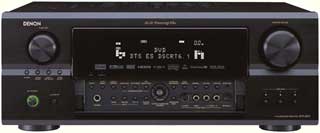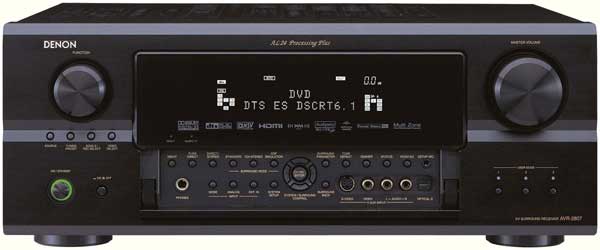Denon AVR-2807 7.1 A/V Receiver Part I October, 2006 Piero Gabucci
|
Introduction
Denon has made a huge impact with some immensely popular A/V receivers the last couple of years - offering some of the most impressive features along with pretty solid performance.
It all started for me,
reviewing the 3805 which seemed like ages ago on the "feature advancement"
calendar. The unique and innovative behemoth AVR-5805 set the
standard for all receivers to follow.
I knew Denon saw this unit as the new line when it changed the numbering
system from ending in 05 to 07, with the 2807 being the first. Recently, they
did the same with the 3806 and 4806 which are decedents essentially of the
5805.
This is different though. For just over a grand, you get 1080p HDMI
video switching, setting a new benchmark. I know, 18 months from now I'll be
saying the same about a remarkable new Denon receiver offering the latest
and greatest, but for now this is the standard.
The Basic Facts
The AVR-2807 is a 7.1 channel receiver, offering 110 watts per channel.
One of those logos on the face includes "7CH-Equal power" which means
there are discrete amplifiers for each channel.
It weighs 32 pounds, fits in a standard 17" wide rack, and stands just under 7" high and about 17" deep.
Click on the photo above to see a larger version.
The Design
If for no other reason, Denon feels comfortable with the current design and
looks of their A/V receivers, and the handsome AVR-2807 falls right in line.
Frankly that's just fine with me; the design is simple and elegant. On the
face you'll find the familiar dual large volume and input selection knobs
flanking a large display screen. As more receivers are getting hidden out of
view these days, I'm glad to see a full display.
Denon continues to have one of the most comprehensive displays out there,
easily readable from a distance and giving the important information during
playback. In terms of speaker configuration, all you have to do is count the
light bars to see which speakers are programmed to operate and which are
actually playing based on the source, two-channel or surround for example. I
like seeing the processing such as Dolby Digital clearly indicated. I enjoy
when I switch inputs, or raise and lower the volume, that it is
displayed. Likewise, I also want the dimming capabilities.
A flip-down panel accesses all the setup and selection features - more on
that later. The familiar green/red glowing
on/off button, along with a few other selections, adorns the façade. In the
display you'll see a few familiar logos and some new ones you may not
recognize. Squarely placed in the middle are a couple they really want you to
notice the most: HDMI and Audyssey. Sure, there are a few you may or may not
have seen before, like XM satellite radio, but for the most part, all
current processing from Dolby Digital and DTS is displayed. There is also the familiar proprietary
analog Denon AL24 Processing Plus that now supports 192 kHz sampling for
processing DVD-Audio through the HDMI input.
On the rear there are no surprises in the layout and plethora of inputs
possible. Beginning with the basics are standard speaker biding posts for up
nine speakers (A and B for the fronts). Analog inputs include DVD, VDP, TV,
DBS, 2 VCR, and Tape Deck. Analog outputs include 2 VCR, Tape and Zone 2.
Separated are audio inputs from a CD player or phono. A full compliment of
analog EXT IN are still required for SACD playback from your DVD player.
There are pre
outs for all channels, typically using the subwoofer only for powered units. Denon's preamps are always excellent quality if you'd prefer using external
power amplifiers.
|
© Copyright 2006 Secrets of Home Theater & High Fidelity |





